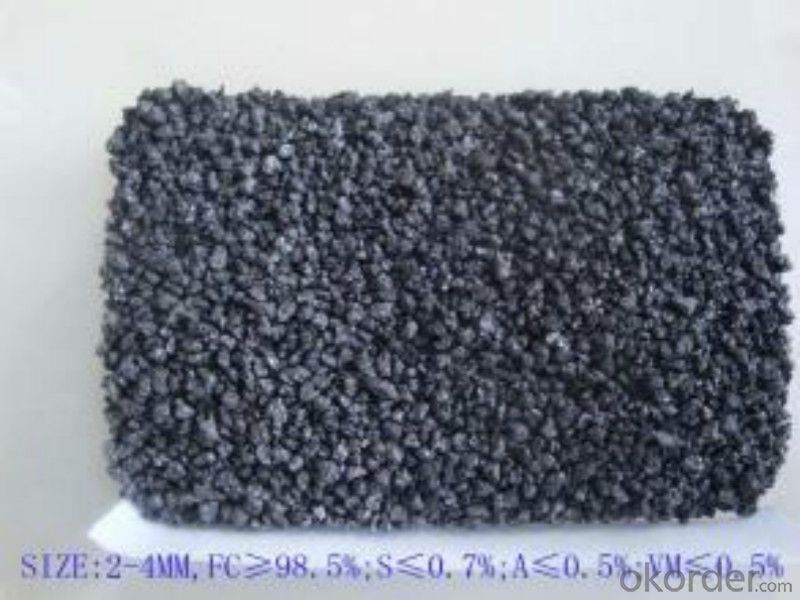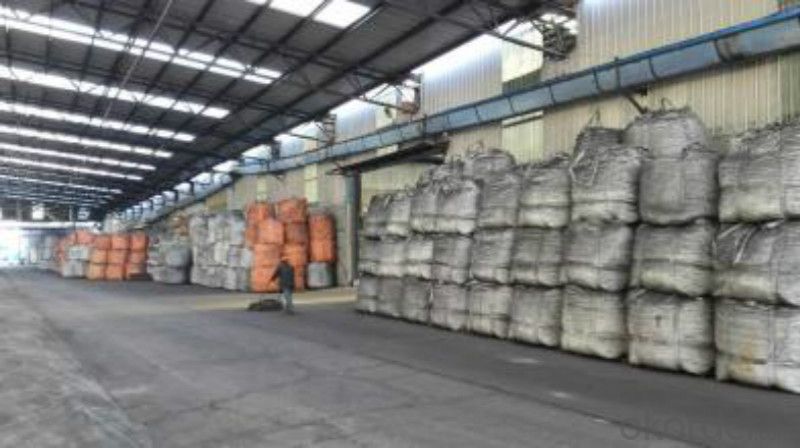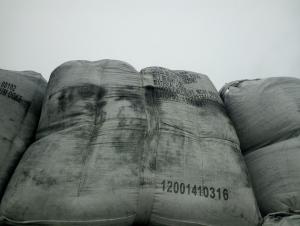Calcined Pitch Coke with Ash 0.5%max for Foudry Industry
- Loading Port:
- Tianjin
- Payment Terms:
- TT OR LC
- Min Order Qty:
- 21 m.t.
- Supply Capability:
- 8000 m.t./month
OKorder Service Pledge
OKorder Financial Service
You Might Also Like
Introduction
Pitch Coke/Coal Tar Pitch is a kind of black brittleness and blocky piece, lustrously at normal temperature. It has special odour and poisonous and can be easily flame when melting, second-grade inflammable solid.
Pitch Coke/Coal Tar Pitch is obtained from powerfully processed coal tar. Compared to petroleum asphalt, the adhesiveness is better. Coal Tar Pitch is high quality tar production with high fixed carbon. It has excellent adhesion, waterproofing and resistance against seawater, oil and various chemicals. In these properties, it is much better than petroleum asphalt tar.
It can be used to produce painting, electrode, pitch coke, and tar felt. It also can be used as fuel and the raw material of asphalt carbon black.
Features:
The morphology, chemistry and crystallinity of recarburisers have a major impact on the overall casting cost. The combined application and cost benefits, which are derived through the use of Desulco, enable foundries to manufacture castings in a highly cost effective manner.
reduces
Recarburiser consumption
Power consumption
Inoculant consumption
MgFeSi consumption
Furnace refractory wear
Scrap rate
Tap to tap time
Slag inclusions risk
Chill
increases
Casting microstructure
Productivity
Process consistency
Carbon Recovery
Compared with calcined petroleum coke, acetylene coke and
graphite electrode scrap, Desulco yields the highest carbon
recovery and fastest dissolution time
Specifications:
CPC | |||
F.C.% | 98.5MIN | 98.5MIN | 98MIN |
ASH % | 0.8MAX | 0.8MAX | 1MAX |
V.M.% | 0.7 MAX | 0.7 MAX | 1 MAX |
SULFUR % | 0. 5MAX | 0. 7MAX | 1MAX |
MOISTURE % | 0.5MAX | 0.5MAX | 1MAX |
Pictures:




FAQ:
1.MOQ:2 Containers |
2.Size:1-3mm,1-5mm,2-6mm,3-5mm and as the customer's requirement |
3.Packing: 1 ton jumbo bag or 25kgs paper in bag |
4.Payment:T/T or L/C at sight |
5.Delivery time: within 15 days after receiving the deposit |
6.Usage: it is as carbon raiser,widely used in steelmaking,casting,casting iron,steel foundry,aluminum metallury. |
- Q:What are the properties of carbon fibers?
- Carbon fibers are known for their exceptional strength and stiffness, making them ideal for applications requiring high-performance materials. They possess a low density, corrosion resistance, and excellent thermal conductivity. Additionally, carbon fibers exhibit high resistance to fatigue and have a high tensile strength, allowing them to withstand extreme conditions. They are also chemically inert and have a low coefficient of thermal expansion, making them versatile for various industries such as aerospace, automotive, and sports equipment.
- Q:What are the impacts of carbon emissions on indigenous communities?
- Carbon emissions have significant impacts on indigenous communities, not only in terms of their environment but also their culture, health, and overall well-being. One of the most direct consequences is the degradation of their traditional lands and natural resources. Indigenous communities often rely on these resources for their livelihoods, including hunting, fishing, and agriculture. Increased carbon emissions contribute to climate change, leading to changes in temperature, weather patterns, and ecosystems, which can disrupt the delicate balance of their ecosystems and make it more difficult for them to sustain their way of life. The loss of traditional lands and resources can also have profound cultural impacts on indigenous communities. For many indigenous peoples, their connection to the land is deeply rooted in their identity and spirituality. When their lands are degraded or destroyed due to carbon emissions, it can lead to the erosion of their cultural practices, knowledge, and traditions. This loss of cultural heritage not only affects indigenous communities but also the broader global society, as their unique knowledge about sustainable land management and conservation practices can offer valuable insights for addressing climate change and protecting our planet. Furthermore, carbon emissions contribute to air pollution, which can have severe health impacts on indigenous communities. Many indigenous communities are located near industrial facilities or fossil fuel extraction sites, resulting in increased exposure to pollutants such as particulate matter, sulfur dioxide, and nitrogen oxides. These pollutants can cause respiratory illnesses, cardiovascular diseases, and other health issues, disproportionately affecting the most vulnerable members of these communities, including children and the elderly. In addition to the immediate health impacts, the long-term consequences of carbon emissions, such as rising sea levels and extreme weather events, further threaten the existence of indigenous communities. Many indigenous communities inhabit low-lying coastal areas or remote regions that are more susceptible to the effects of climate change, including coastal erosion, flooding, and loss of traditional food sources. These changes not only disrupt their way of life but also force them to consider relocation, which often leads to the loss of their cultural identity and connection to their ancestral lands. Addressing carbon emissions and mitigating climate change is crucial for the well-being and survival of indigenous communities. It requires recognizing their rights to their traditional lands, resources, and self-determination, as well as involving them in decision-making processes concerning environmental conservation. Supporting sustainable development projects that prioritize local needs and indigenous knowledge can help foster resilient communities that can adapt to the changing climate. Ultimately, by reducing carbon emissions and protecting the environment, we can help preserve the cultural diversity and invaluable contributions of indigenous communities for generations to come.
- Q:How is carbon used in the production of adhesives?
- Carbon is used in the production of adhesives as a key component in creating the adhesive's base material. Carbon-based compounds, such as resins or polymers, are often used to form the adhesive's structure, providing strength, flexibility, and adhesion properties. These carbon-based materials can be synthesized or derived from natural sources like petroleum or plants. Overall, carbon plays a crucial role in the formulation of adhesives, enabling them to bond various materials together effectively.
- Q:What are the impacts of carbon emissions on the stability of mountains?
- Carbon emissions can have various impacts on the stability of mountains. One significant effect is the acceleration of glacial melting, leading to increased water runoff and the potential for more frequent and severe landslides. Additionally, carbon dioxide contributes to the acidification of rainwater, which can corrode rocks and weaken the stability of mountain slopes. Climate change, driven by carbon emissions, also leads to alterations in precipitation patterns, temperature, and weather events, increasing the risk of erosion, rockfalls, and avalanches. Overall, carbon emissions have a detrimental influence on the stability of mountains, posing risks to both human populations and ecosystems.
- Q:What are the impacts of carbon emissions on the stability of coastal areas?
- Carbon emissions have significant impacts on the stability of coastal areas. The primary consequence is the acceleration of global warming, leading to rising sea levels and increased frequency and intensity of coastal storms. This combination results in erosion, coastal flooding, and loss of land, endangering ecosystems, infrastructure, and human settlements. Additionally, carbon emissions contribute to ocean acidification, harming marine life and disrupting delicate coastal ecosystems. Therefore, reducing carbon emissions is crucial to mitigate these adverse effects and ensure the long-term stability of coastal areas.
- Q:How dnf advanced carbon ashes?
- That thing is called the advanced furnace rock carbon... Not ash carbon...... It was bought at the mall (sold before, no now), with a success rate plus ten percent.
- Q:How does carbon impact air quality?
- Carbon can have a significant impact on air quality through the release of carbon dioxide (CO2) and other carbon-based pollutants into the atmosphere. The burning of fossil fuels, such as coal, oil, and natural gas, releases large amounts of carbon dioxide, which is a greenhouse gas responsible for climate change. Increased levels of carbon dioxide in the atmosphere contribute to the warming of the Earth's surface, leading to adverse effects on air quality. Furthermore, carbon-based pollutants, including carbon monoxide (CO) and volatile organic compounds (VOCs), can be emitted during the incomplete combustion of fossil fuels or other organic materials. These pollutants have harmful effects on human health and can contribute to the formation of ground-level ozone, a major component of smog. Ozone can cause respiratory problems, lung damage, and worsen existing respiratory conditions such as asthma. Additionally, carbon particles, known as black carbon or soot, are released from the burning of fossil fuels, biomass, and other organic matter. These particles can directly impact air quality by absorbing sunlight and reducing visibility. Moreover, when these particles are inhaled, they can penetrate deep into the lungs, causing respiratory issues and potentially leading to long-term health problems. Reducing carbon emissions is crucial for improving air quality and mitigating the negative impacts on human health and the environment. Transitioning to cleaner and more sustainable energy sources, such as renewable energy, can help reduce carbon emissions and improve air quality. Implementing stricter regulations and emission standards for industries and vehicles can also contribute to reducing carbon pollution and improving overall air quality.
- Q:How does carbon affect the formation of heatwaves?
- Carbon dioxide, a greenhouse gas, plays a significant role in the formation of heatwaves. When carbon dioxide is released into the atmosphere through human activities such as burning fossil fuels and deforestation, it acts as a blanket, trapping heat from the sun and preventing it from escaping back into space. This phenomenon is known as the greenhouse effect. As carbon dioxide levels continue to rise, the Earth's temperature also increases, leading to more frequent and intense heatwaves. The excess heat trapped in the atmosphere creates a feedback loop, further exacerbating the problem. Heatwaves occur when high-pressure systems stall over a region for an extended period, causing temperatures to soar well above average. Carbon not only influences the intensity of heatwaves but also their duration. The increased greenhouse effect prolongs the time during which heatwaves persist, making them more dangerous and damaging. This prolonged exposure to extreme heat can have severe consequences on human health, leading to heat-related illnesses, increased mortality rates, and reduced productivity. Furthermore, carbon emissions contribute to climate change, which alters weather patterns and leads to more extreme events like heatwaves. Climate models project that heatwaves will become more frequent, longer-lasting, and intense in the future if carbon emissions are not significantly reduced. Addressing the issue of carbon emissions is crucial in mitigating the impacts of heatwaves. Transitioning to cleaner and renewable energy sources, implementing energy efficiency measures, and promoting reforestation efforts are some of the steps that can be taken to reduce carbon dioxide levels. By doing so, we can mitigate the formation of heatwaves and protect both human health and the environment.
- Q:How is carbon used in the production of fuel cells?
- Fuel cells utilize carbon in various ways during their production. The construction of electrodes is one of the primary applications of carbon in fuel cells. These electrodes, which consist of an anode and a cathode, are commonly made from carbon-based materials like graphite or carbon paper. These materials enable the electrochemical reactions within the fuel cell to occur by offering a conductive surface. Furthermore, carbon serves as a catalyst in fuel cells. Catalysts are substances that accelerate chemical reactions without being consumed in the process. Carbon-based catalysts, such as platinum or palladium, are frequently employed in fuel cells to facilitate the reactions that generate electricity. These catalysts enhance the efficiency of fuel-to-electricity conversion. Moreover, carbon is employed in the form of carbon nanotubes during fuel cell production. Carbon nanotubes exhibit unique properties such as high surface area and exceptional electrical conductivity, making them ideal for enhancing fuel cell performance. By providing a larger surface area for reactions to occur on, carbon nanotubes can improve the efficiency of fuel cell reactions. In summary, carbon plays a vital role in fuel cell production by providing the necessary materials for electrode construction, acting as catalysts for electrochemical reactions, and enhancing fuel cell performance through the utilization of carbon nanotubes.
- Q:How does carbon affect the formation of volcanic eruptions?
- The formation of volcanic eruptions can be significantly influenced by carbon. One way in which carbon impacts volcanic eruptions is through the degassing process. When magma rises to the surface, it carries dissolved gases, including carbon dioxide. As the magma moves towards the surface and the pressure decreases, the dissolved gases begin to separate, forming gas bubbles within the magma. These gas bubbles can make the magma more buoyant, facilitating its ascent and eventually leading to an eruption. In addition, carbon can also affect the viscosity of magma, which measures its resistance to flow. Magma with higher carbon content tends to have lower viscosity, making it more fluid-like and capable of flowing more easily. This reduced viscosity enables the magma to move more swiftly towards the surface, increasing the chances of an eruption. Moreover, carbon can contribute to the explosiveness of volcanic eruptions. When magma reaches the surface, it can come into contact with organic matter, such as plant material or fossil fuels, which contain abundant carbon. This interaction can result in the combustion of the organic matter, releasing additional gases like methane. These gases can further elevate the pressure within the volcano, leading to more explosive eruptions. In summary, carbon plays a crucial role in the formation of volcanic eruptions. It influences the buoyancy and viscosity of magma and can contribute to the explosiveness of eruptions. Understanding the impact of carbon in volcanic processes is vital for predicting and mitigating the risks associated with volcanic activity.
1. Manufacturer Overview |
|
|---|---|
| Location | |
| Year Established | |
| Annual Output Value | |
| Main Markets | |
| Company Certifications | |
2. Manufacturer Certificates |
|
|---|---|
| a) Certification Name | |
| Range | |
| Reference | |
| Validity Period | |
3. Manufacturer Capability |
|
|---|---|
| a)Trade Capacity | |
| Nearest Port | |
| Export Percentage | |
| No.of Employees in Trade Department | |
| Language Spoken: | |
| b)Factory Information | |
| Factory Size: | |
| No. of Production Lines | |
| Contract Manufacturing | |
| Product Price Range | |
Send your message to us
Calcined Pitch Coke with Ash 0.5%max for Foudry Industry
- Loading Port:
- Tianjin
- Payment Terms:
- TT OR LC
- Min Order Qty:
- 21 m.t.
- Supply Capability:
- 8000 m.t./month
OKorder Service Pledge
OKorder Financial Service
Similar products
New products
Hot products





























